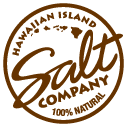Frequently Asked Questions
Not all salt is salt and not all sea salt is from the pure, clear waters of Hawaii. Please check here to see if our FAQs help answer any question you have before you purchase or fill out the Contact Us form and we’ll make sure to respond to you right away.
What is Salt?
Common salt, or sodium chloride, is the chemical compound NaCl. Salt occurs naturally in many parts of the world as the mineral halite and as mixed evaporates in salt lakes.
What is one of the best sources of this natural nutrient?
Seawater. Containing lots of salt, it has an average of 2.6% NaCl (by weight). Seawater provides an inexhaustible supply (Note: Seawater also contains other dissolved solids; salt represents about 77% of the Total Dissolved Solids).
Where does table salt come from?
Underground salt deposits are what is found in both imbedded sedimentary layers and dome deposits. Salt deposits have been found to have encapsulated ancient microorganisms including bacteria. Some salt is on the earth's surface, such as the dried-up residue of ancient seas like the famed Bonneville Salt Flats in Utah. Salt even arrives on earth from outer space, and its presence on the planet Mars has led scientists to think life may exist there (or at least be supportable). Amazingly, surface salt deposits and man-made salt works can even be seen from space.
What does a salt crystal look like?
Sodium chloride crystals are cubic in form. Table salt consists of tiny cubes tightly bound together through ionic bonding of the sodium and chloride ions. The salt crystal is often used as an example of crystalline structure. The size and shape of salt crystals can be modified by temperature. Sodium chloride is available in several different particle sizes (gradation) and forms, depending on what the intended end use is.
Salt varies in color from colorless when pure, to white, gray or brownish, which is typical of rock salt (halite). Chemically, salt is 60.663% elemental chlorine (Cl) and 39.337% sodium (Na). The atomic weight of elemental chlorine is 35.4527 and that of sodium is 22.989768. Properties of salt are collected in the U.S. Occupational Safety and Health Administration (OSHA) Chemical Sampling Information database.
What is the relation between Salt and Health?
For years, we have known that salt intake can affect blood pressure through signals to the muscles of blood vessels trying to maintain blood pressure within a proper range. We know that a minority of the population can lower blood pressure by restricting dietary salt. And we know that elevated blood pressure, hypertension, is a well-documented marker or "risk factor" for cardiovascular events like heart attacks and strokes, a "silent killer" Cardiovascular events are a major cause of premature death and cost Americans more than $300 billion every year in increased medical costs and lost productivity. Reducing blood pressure can reduce the risk of a heart attack or stroke - depending on how it's done.
Salt, like most any food, can be harmful if abused. The key to overall health is good unprocessed food and proper exercise. Salt taken in moderation can add quality to your dining experience. Please eat responsibly.
What are some salt tips?
Besides making food delicious, it's believed there are more than 12,000 uses for salt, and our grandmothers were probably familiar with most of them. A number of these uses were for simple things around the home before the advent of modern chemicals and cleaners.
Many of these salt uses are still valid today and can be much cheaper and more environmentally-friendly than more sophisticated products. We make no guarantee about the results if you try any of these uses and tips, but there must be something to them since they have been handed down over the years in many households. Most of these salt uses have stood the test of time.




